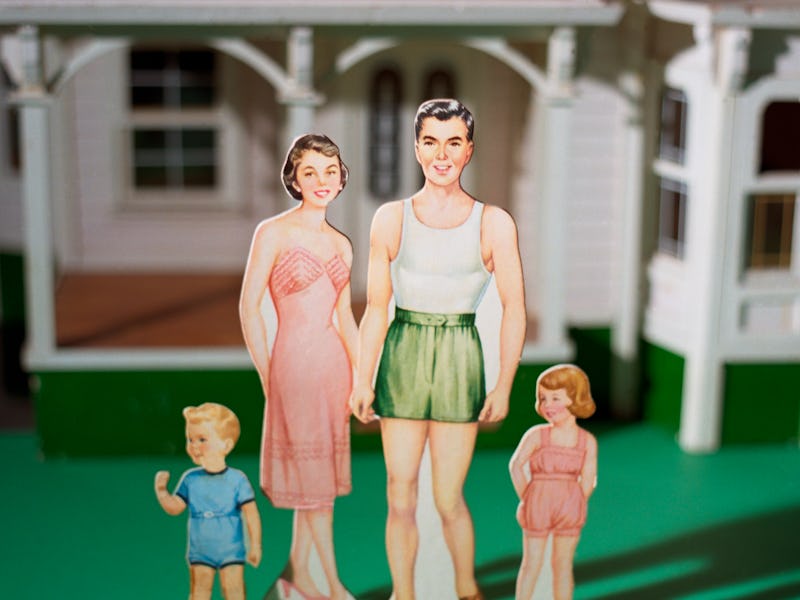New study debunks evolutionary theory explaining male and female bodies
Researchers debunk a longstanding hypothesis about human evolution.

Why do male and female bodies look the way they do? Compared to species like elephant seals and peacocks, we’re outright boring — similar flesh suits sharing similar lumps.
It’s understood evolution drives the overall process, but scientists are on the hunt to understand the specifics — and debunking some theories in the process.
One idea is that way back in hunter-gatherer days males had to be strong to hunt and thus evolved to have more strength than females. This implies that when humans transitioned to farming, changes in the human body (like weaker bones) reflected that adaptation. Male and female bodies, in turn, evolved to be more similar to each other because of farming — or so goes the theory.
But using genetic data, researchers from Pennsylvania State University may have irrefutably debunked that idea.
The researchers’ results, published Thursday in the journal of PLOS Genetics, suggest there’s no evidence that sex differences decreased as a result of natural selection in the agricultural era. Further, their results underscore the value of using genetic data to test anthropological hypotheses.
What you need to know first — Some researchers believe certain species with sexually differentiated traits — one sex has specific physical traits that the other sex doesn’t have — is the result of natural selection.
For example, while both male and female deer have antlers, stags and bucks (male deer) have antlers that are much bigger than the females. Stags use their antlers to fight other stags over mates; the buck with the biggest and strongest antlers is likely to have his choice of mate.
In humans, those sexually differentiated traits exist but are much more subtle. (For example, females tend to be shorter than males of the same population.) But we don’t know why that is, and the scientific community offers no clear consensus. The authors of the study say there are two sides to this debate:
- The first argues that the degree of sexual differentiation for body size phenotypes in Europe decreased following shifts from a foraging-based subsistence strategy to an agricultural one “in response to less pronounced divisions of labor and mobility.”
- The second side claims that evolution happens too slowly for sexually differentiated phenotypes to respond to a shift that happened within the last 10,000 years. Thus, this side argues, any changes are likely the result of genetics and/or environmental factors rather than natural selection.
To find out which side is correct, the researchers used “genomic and evolutionary analysis” to determine how changes in lifestyle and culture might be affecting these sexually differentiated traits.
How they did it — Co-author Audrey Arner is a research technologist at Penn State University. She tells Inverse her team used data from the UK Biobank, a huge database comprised of genetic and health information, to “identify genetic variants in the genome that are differentially associated with trait variation between females and males for five different body size and shape phenotypes.”
The five traits were:
- Body mass
- Height
- Hip circumference
- Body fat percentage
- Waist circumference
By evaluating these sex-differentiated traits in the genomic data of 194,000 females and 167,000 males, researchers could “examine whether these identified variants have been under recent selection, and if so, in what direction,” Arner says.
What they found — If a transition to farming was responsible for changes in sex phenotypes, the researchers would have expected to see genetic variations associated with all of those traits become more or less common over the 3,000 years.
But only one variation out of the 3,000 variations in the human genome linked to those five traits became significantly more common during that time period, at least in the population of the United Kingdom: the variation associated with higher body fat in females.
“We did not find evidence of selection on sex difference-associated loci for any of the other traits we examined,” Arner explains.
This result, she says, contradicts the hypothesis that differences in male and female bodies became less pronounced as humans transitioned from hunting and gathering to farming.
Though the researchers’ results are specific to the United Kingdom, the study highlights the promise of genomic analysis.
The Inverse analysis—There’s so much we don’t know about how male and female humans evolved. Researchers were able to debunk a longstanding hypothesis about natural selection and farming through genetic analysis. Perhaps the answers will be found in the most complex set of instructions on earth: the human genome.
Abstract: There is uncertainty regarding the evolutionary history of human sex differences for quantitative body size and shape phenotypes. In this study we identified thousands of genetic loci that differentially impact body size and shape trait variation between females and males using a large sample of UK Biobank individuals. After confirming the biological plausibility of these loci, we used a population genomics approach to study the recent (over the past ~3,000 years) evolutionary histories of these loci in this population. We observed significant increases in the frequencies of alleles associated with greater body fat percentage in females. This result is contradictory to longstanding hypotheses that sex differences have adaptively decreased following subsistence transitions from hunting and gathering to agriculture.
This article was originally published on